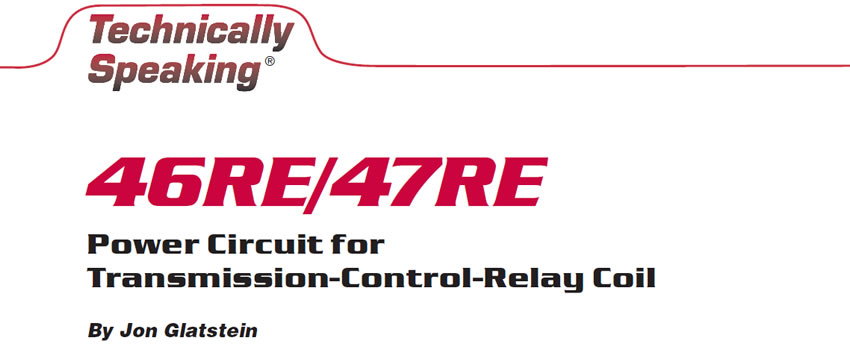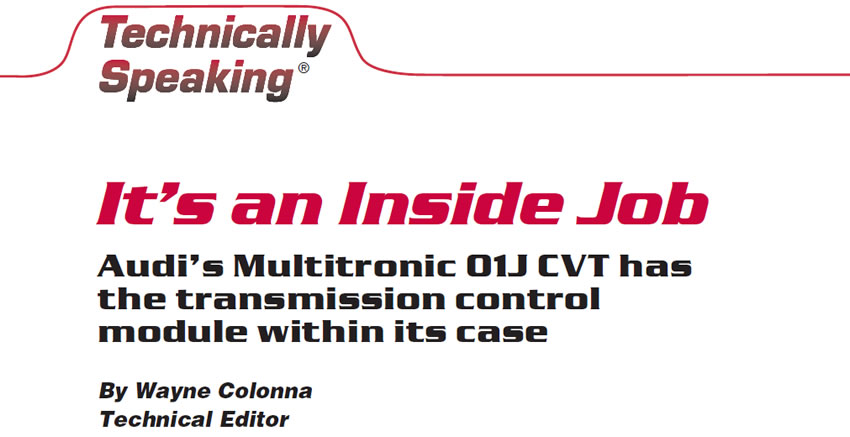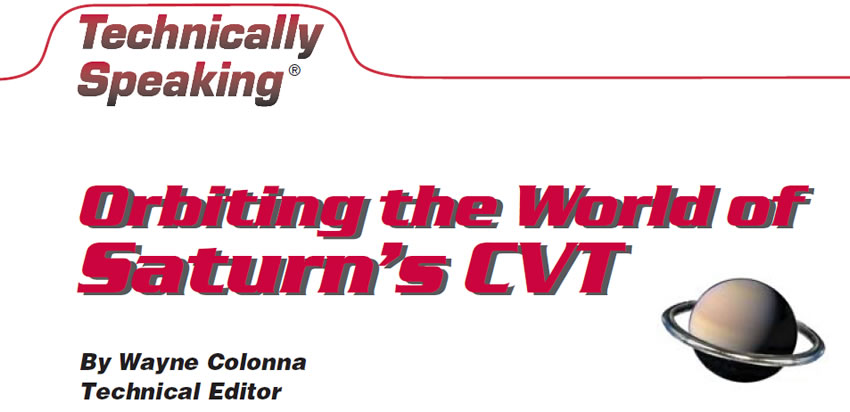46RE/47RE: Power Circuit for Transmission-Control-Relay Coil
46RE and 47RE units (and some 42/44RE units after 1996) use an interesting method to energize the coil of the transmission-control relay. As we all know, the switch part of the transmission-control relay is what provides battery power to the solenoids when its coil is energized.

Ford 5R110W (‘TorqShift’)
Preliminary Information The new Ford 5R110W, referred to by Ford Motor Co. as the “TorqShift” transmission, is a redesign of the 4R100 with some previous strategy applied. This unit was introduced in model year 2003 in the F-Series trucks and Excursions equipped with the new 6.0L diesel engine. The TorqShift is a five-speed, rear-wheel-drive unit

An Optical Illusion
There is nothing more frustrating for any technician and/or shop owner than to encounter a late-model vehicle experiencing problems and have no diagnostic codes to go by. One well-experienced example of this would be with pre-1996 vehicles. Many different styles of electronic transmissions would not set a code for an inhibitor switch because there were no codes for the computer to produce. So when it would malfunction, it would leave the technician clueless as to the source of the problem.

It’s an Inside Job
The 2003-and-up Audi A4 and the 2002-and-up A6 with a 1.8- or 3.0-liter engine use a continuously variable automatic transmission known as the Multitronic® 01J (see Figure 1) and also referred to as the VL300. The core of this article is not that this transmission is a CVT. The focus is on what’s inside the transmission other than the drive- and driven-pulley set.

Orbiting the World of Saturn’s CVT
The VT20/25-E CVT transaxle, otherwise known simply as VTi, is a transmission built in the Fiat GM Powertrain Plant in Hungary and is on the road in the United States in Saturn’s Vue SUV and in the Ion Quad Coupe.

Ford 4F27E Shift Strategy – a Different Way of Doing Things
The 4F27E transmission uses two on/off solenoids and three PWM solenoids to produce each of the shifts and converter-clutch apply, as the chart in Figure 1 shows. The EPC solenoid is used to control line pressure relative to engine torque. So far this sounds easy, but from a strategy standpoint, it progressively moves toward a “different way of doing things” when compared with what we are accustomed to.

I Don’t Like the Cold
The past winter months brought to surface a condition of no upshift from first gear when cold with the SAAB/Volvo 50-42LE transmission. When it warms up, all shift sequences are restored. The time in which this occurs varies.

I Lost My EPC!
The AODE/4R70W transmission has a problem with wear in the pressure-regulator-valve bore that can cause a reduction or complete loss of EPC pressure when the unit is hot. This equates to no or minimal line rise, causing the transmission to have medium- to full-throttle slipping in gear and sliding shifts.
Once a pressure gauge has revealed that EPC pressure remains near 0 at any throttle opening (as well as when the transmission is unplugged), the technician usually replaces the EPC solenoid, yet the problem remains.

Fast, Easy and Simple
It may have taken a while for transfer-case technology to catch up with the technology seen in transmissions, but it has, in fact, arrived and it shows no signs of letting up. The Sport Trac, Control Trac II, Active On-Demand 4WD operation and Progressive On-Demand 4WD operation are examples of the types of computer-controlled transfer cases on the road today.

Simply Complicated
It is in these two vehicles (Tracker and Sidekick) that we find a TCC system distinct from that used in any of the earlier TCC-equipped designs. Figures 1 and 2 show the internal adaptation and description of the components used to control converter-clutch apply. There we see that a TCC solenoid is fitted with some plumbing. The bottom pipe coming from the valve body is band-release pressure, otherwise known as 3rd-gear oil. This ensures that the vehicle will never have TCC until 3rd gear. When the solenoid is energized, this oil is routed through the upper pipe to the pump cover (see figures 3 and 4), where it strokes the converter-clutch control valve into a lockup position.

Manual Updates for a Couple of Mazda Valve Bodies
On occasions technicians may find themselves fighting a loss of line-pressure rise with a GF4A-EL transaxle. The transmission has been unplugged and line pressure still does not rise, verifying that there is, in fact, an internal transmission concern. The pressure-control solenoid has been replaced, the pump and spool valve have been inspected and determined to be in proper working order, and the pan has not been pushed up into the newly installed filter.

A Case of a Leaking Capacitor
It is not uncommon to hear of a technician investigating the inside of a computer as part of a diagnostic routine, especially when dealing with odd continual electrical problems.
Sometimes when the box is opened, a distinct burnt odor confirms the technician’s hunch that it was fried “Fred” causing the problem all along. Sometimes a cracked circuit board is the cause of those pesky intermittent trouble codes. On other occasions the box is filled with water from a leaking sunroof (Honda/Acura) or a leaking heater core (Mitsubishi/Hyundai), or it just had the misfortune of being in a flood.

